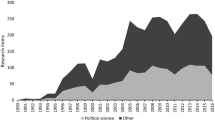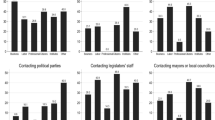Abstract
This paper examines the relationship between public support and private donations by disaggregating the crowding effect into two components: one determined by level of public support and one determined by changes in public support levels. The analysis of a panel of American non-profit theatres shows that the crowding effect induced by the level of public support takes an inverted U shape: at low levels public support crowds-in private donations while at higher levels it displaces them. The change in total public support in the past year produces a constant crowding-in effect on the level of private donations. The paper finally illustrates how federal and state support have a crowding-in effect at all levels, while local support has a similar impact to total public support.
Similar content being viewed by others
References
Abrams, B. A., & Schmitz, M. D. (1978). The ‘crowding-out’ effect of government transfers on private charitable contributions. Public Choice, 33(1), 29–39.
Abrams, B. A., & Schmitz, M. D. (1985). The crowding-out effect of governmental transfers: A rejoinder. National Tax Journal, 38(4), 575–576.
Amos, O. M. (1982). Empirical analysis of motives underlying individual contributions to charity. Atlantic Economic Journal, 10(4), 45–52.
Andreoni, J. (1989). Giving with impure altruism: Applications to charity and Ricardian equivalence. Journal of Political Economy, 97, 1447–1458.
Andreoni, J. (1993). An experimental test of the public goods crowding-out hypothesis. American Economic Review, 83(5), 1317–1327.
Andreoni, J. (2001). Economics of philanthropy. In N. Smeltser & P. Baltes (Eds.), International Encyclopedia of Social and Behavioral Sciences. Oxford: Elsevier.
Andreoni, J., & Payne, A. A. (2001). Government Grants to Private Charities: Do They Crowd Out Giving or Fundraising? Department of Economics Working Paper, University of Wisconsin.
Becker, G. S. (1974). A theory of social interactions. Journal of Political Economy, 82(6), 1063–1093.
Bolton, G. E., & Katok, E. (1998). An experimental test of the crowding out hypothesis: The nature of beneficent behavior. Journal of Economic Behavior and Organization, 37, 315–331.
Borgonovi, F., & O'Hare, M. (2004). The impact of the National Endowment for the arts in the United States: Institutional and sectoral effects on private funding. Journal of Cultural Economics, 28(1), 21–36.
Boulding, K. E. (1962). Notes on a theory of philanthropy. In F. G. Dickinson (Ed.), Philanthropy and Public Policy. New York: National Bureau of Economic Research.
Brooks, A. C. (1999). Do public subsidies leverage private philanthropy for the arts? Empirical evidence on symphony orchestras. Nonprofit and Voluntary Sector Quarterly, 28(1), 32–45.
Brooks, A. C. (2000). Public subsidies and charitable giving: Crowding out, crowding in, or both? Journal of Policy Analysis and Management, 19(3), 451–464.
Brooks, A. C. (2003). Taxes, subsidies, and listeners like you: Public policy and contributions to public radio. Public Administration Review, 63(5), 554–561.
Clotfelter, C. T. (1985). Federal Tax Policy and Charitable Giving. Chicago: The University of Chicago Press.
Connolly, L. S. (1997). Does external funding of academic research crowd out institutional support? Journal of Public Economics, 64, 389–406.
Day, K. M., & Devlin, R. A. (1996). Volunteerism and crowding out: Canadian econometric evidence. Canadian Journal of Economics, 29(1), 37–53.
Frey, B.S., & Jegen, R. (2001) Motivation crowding theory. Journal of Economic Surveys, 15, 589–611.
Frey, B. S., & Oberholzer-Gee, F. (1997). The cost of price incentives: An empirical analysis of motivation crowding-out. American Economic Review, 87, 746–755.
Greene, W. H. (1997). Econometric Analysis. Upper Saddle River: Prentice Hall.
Heilbrun, J., & Gray, C. M. (2001). The Economics of Art and Culture. Cambridge: Cambridge University Press.
Hochman, H. M., & Rodgers, J. D. (1973). Utility interdependence and income transfers through charity. In K. E. Boulding, M. Pfaff, & A. Pfaff (Eds.), Transfers on an Urbanized Economy: Theories and Effects of the Grants Economy. California: Belmont.
Hodsoll, F. S. M. (1984). Supporting the arts in the eighties: The view from the National Endowment for the Arts. Annals of American Academy of Political and Social Science, 471, 84–88.
Hughes, P. N., & Luksetich, W. (1997). The Relationship among Funding Sources for Art and History Museums. Paper presented at ARNOVA Conference, Indianapolis.
Independent Sector (1994). Giving and volunteering in the United States: Findings from a National survey 1994 edition. Independent Sector, Washington D.C.
Khanna, J., Posnett, J., & Sandler, T. (1995). Charity donations in the UK: New evidence based on panel data. Journal of Public Economics, 56, 257–272.
Kingma, B. R. (1989). An accurate measurement of the crowd-out effect, income effect, and price effect for charitable contributions. Journal of Political Economy, 97(5), 1197–1207.
Lange, M. D., & Luksetich, W. A. (1984). Demand elasticities for symphony orchestras. Journal of Cultural Economics, 8(1), 29–47.
Mulcahy, K. V. (1992). Government and the arts in the United States. In R. A. Smith & R. Berman (Eds.), Public Policy and the Aesthetic Interest. Chicago: University of Illinois Press.
National Endowment for the Arts (1998). NEA strategic plan 1999–2004. National Endowment for the Arts, Washington D.C.
Nyborg, K., & Rege, M. (2003). Does public policy crowd out private contributions to public goods? Public Choice, 115, 397–418.
Paqué, K. H. (1982). Do public transfers “crowd out” private charitable giving? Some econometric evidence for the federal republic of Germany. Kiel Working Paper No. 152, University of Kiel.
Payne, A. A. (1998). Does the government crowd-out private donations? New evidence from a sample of non-profit firms. Journal of Public Economics, 69, 323–345.
Reece, W. S. (1979). Charitable contributions: New evidence on household behavior. American Economic Review, 69(1), 142–151.
Roberts, R. D. (1984). A positive model of private charity and public transfers. Journal of Political Economy, 92(1), 136–148.
Rose-Ackerman, S. (1986). Do government grants to charity reduce private donations? In S. Rose-Ackerman (Ed.), The Economics of Nonprofit Institutions. New York: Oxford University Press.
Rabin, M. (1997). Psychology and Economics. Berkeley Department of Economics Working Paper, No. 97–251. University of California, Berkeley.
Schiff, J. (1985). Does government spending crowd out charitable contributions? National Tax Journal, 38(4), 535–546.
Schuster, J. M. D. (1985). The interrelationship between public and private funding of the arts in the United States. Journal of Arts Management and Law, 14(4), 77–105.
Schuster, J. M. D. (1989). Government leverage of private support: Matching grants and the problem with “new” money. In M. Wyszomirski & P. Clubb (Eds.), The Cost of Culture. Patterns and Prospects of Private Arts Patronage. New York: ACA Books.
Schwartz, R. A. (1970). Personal philanthropic contributions. Journal of Political Economy, 78(6), 1264–1291.
Smith, T. M. (2003). Raising the Barre: The geographic, financial, and economic trends of non-profit dance companies. Research Division Report #44. National Endowment for the Arts, Washington D.C.
Steinberg, R. (1985). Empirical relations between government spending and charitable donations. Journal of Voluntary Action Research, 14(2), 54–64.
Steinberg, R. (1991). Does government spending crowd out donations? Interpreting the evidence. Annals of Public and Co-operative Economics, 62, 591–617.
Throsby, C. D. (1983). Perception of quality in demand for the theatre. In W. S. Hendon & J. L. Shanahan (Eds.), Economics of Cultural Decisions. Cambridge: Abt Books.
U.S. Census Bureau. (2000). Sources of receipts or revenue. 1997 Economic Census. Arts, entertainment and recreation. U.S. Census Bureau, Washington D.C.
Vesterlund, L. (2003). The informational value of sequential fundraising. Journal of Public Economics, 87, 627–657.
Vickery, W. S. (1962). One economist's view of philanthropy. In F. G. Dickinson (Ed.), Philanthropy and Public Policy. New York: National Bureau of Economic Research.
Warr, P. G. (1982). Pareto optimal redistribution and private charity. Journal of Public Economics, 19, 131–138.
Wyszomirski, M. J., & Mulcahy, K. V. (1995). The organization of public support for the arts. In K. V. Mulcahy & M. J. Wyszomirski (Eds.), America's Commitment to Culture. Boulder: Westview Press.
Author information
Authors and Affiliations
Corresponding author
Rights and permissions
About this article
Cite this article
Borgonovi, F. Do public grants to American theatres crowd-out private donations?. Public Choice 126, 429–451 (2006). https://doi.org/10.1007/s11127-006-3887-z
Accepted:
Issue Date:
DOI: https://doi.org/10.1007/s11127-006-3887-z




